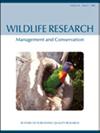澳大利亚野鹿病毒和寄生虫感染与牲畜和人类健康的关系综述
IF 1.6
3区 生物学
Q3 ECOLOGY
引用次数: 1
摘要
野生动物携带多种病原体。在欧洲和北美,鹿科(鹿科)可以作为病毒、朊病毒、细菌和寄生虫感染的宿主。野鹿通常居住在农业用地上,因此,由于它们有可能将疾病传播给牲畜,因此构成了生物安全风险。多项研究调查了澳大利亚野鹿的感染状况,主要是在20世纪70年代和80年代,从那时起,鹿的数量和分布都大大增加。这些研究为澳大利亚野鹿携带的病原体提供了重要的基线,但受样本量小、研究的鹿种数量少以及所使用的疾病检测方法的限制。最近使用ELISA(酶联免疫吸附试验)、基于pcr的测定和下一代测序的研究大大增加了我们对澳大利亚鹿病毒和寄生虫感染的了解。这些研究表明鹿可能是鼠疫病毒、犬新孢子虫和牛内阿米巴等病原体的宿主。新一代测序的使用导致发现了新型病毒,如小核糖核酸病毒和博匹病毒属的一种新种,这两种病毒都对家畜构成传播风险。最近的研究证实,野鹿可能是家畜和其他野生动物的病毒和寄生虫感染的未来来源。本文章由计算机程序翻译,如有差异,请以英文原文为准。
A review of viral and parasitic infections in wild deer in Australia with relevance to livestock and human health
ABSTRACT Wild animals harbour a diverse range of pathogens. In Europe and North America, cervids (Family Cervidae) can act as reservoirs for viral, prion, bacterial, and parasitic infections. Wild deer often inhabit agricultural land, therefore representing a biosecurity risk due to their potential ability to transmit diseases to livestock. Multiple studies have investigated the infection status of wild deer in Australia, mostly during the 1970s and 1980s, and deer populations have increased greatly in abundance and distribution since then. Those studies provide an important baseline for the pathogens carried by wild deer in Australia but are limited by small sample size, the small number of deer species studied, and the disease detection methods used. Recent investigations using ELISA (Enzyme-Linked Immunosorbent Assay), PCR-based assays, and next-generation sequencing have substantially increased our understanding of viral and parasitic infections in Australian deer. These studies indicate that deer may act as reservoirs for pathogens such as Pestivirus, Neospora caninum and Entamoeba bovis. The use of next-generation sequencing has led to the discovery of novel viruses such as Picobirnavirus and a novel species of the genus Bopivirus, both of which pose transmission risks for domestic animals. Recent research confirms that wild deer could be a future source of viral and parasitic infections for domestic livestock and other wildlife species.
求助全文
通过发布文献求助,成功后即可免费获取论文全文。
去求助
来源期刊

Wildlife Research
生物-动物学
CiteScore
4.30
自引率
15.80%
发文量
56
审稿时长
3 months
期刊介绍:
Wildlife Research represents an international forum for the publication of research and debate on the ecology, management and conservation of wild animals in natural and modified habitats. The journal combines basic research in wildlife ecology with advances in science-based management practice. Subject areas include: applied ecology; conservation biology; ecosystem management; management of over-abundant, pest and invasive species; global change and wildlife management; diseases and their impacts on wildlife populations; human dimensions of management and conservation; assessing management outcomes; and the implications of wildlife research for policy development. Readers can expect a range of papers covering well-structured field studies, manipulative experiments, and analytical and modelling studies. All articles aim to improve the practice of wildlife management and contribute conceptual advances to our knowledge and understanding of wildlife ecology.
Wildlife Research is a vital resource for wildlife scientists, students and managers, applied ecologists, conservation biologists, environmental consultants and NGOs and government policy advisors.
Wildlife Research is published with the endorsement of the Commonwealth Scientific and Industrial Research Organisation (CSIRO) and the Australian Academy of Science.
 求助内容:
求助内容: 应助结果提醒方式:
应助结果提醒方式:


